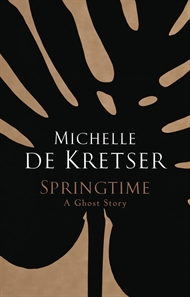lip lit: springtime: a ghost story
Frances and her partner Charlie have left their old lives to start over in Sydney. Coming from Melbourne, with its grid-mapped streets and dark, sensible fashions, Frances feels like an outsider in a city that yields to the natural landscape. On lonely spring days she takes her rescue dog, Rod, for long walks along the river, marvelling at the garish September blooms and lush foliage that tumbles over fences and shadows her path. It is on one of these walks that she first sees the silent woman in the old-fashioned dress.
Springtime, a long short story from Miles Franklin Award winner Michelle de Krester, approaches the traditional ghost story from a new angle. At a dinner party a writer tells Frances:
Do you know this idea that electricity put an end to ghost stories? People stopped seeing ghosts when rooms were properly lit … The way stories were written changed around that time. Ghost stories work up to a shock, but the modern form of the short story is different. When a loose, open kind of story came in, writing about ghosts went out.
In Springtime de Krester asks what form ghosts and haunting might take in a fluid narrative that does not turn on the ‘shock’ or ‘single effect’. Edgar Allan Poe described this in his essay on the short story, ‘On the Importance of the Single Effect in a Prose Tale’ (1847):
Having conceived, with deliberate care, a certain unique or single effect to be wrought out, [the writer] then invents such incidents—he then combines such events as may best aid him in establishing this preconceived effect.
Springtime contains many familiar Gothic tropes: eerie, unexplained phone calls during which a mechanical voice tells Frances ‘Goodbye’; Frances’ step-son appearing at her bedside in the middle of the night to ask if she’s dead in a disturbing echo of Frances’ own childhood nightmares; the silent woman in the old-fashioned dress who appears as ‘a sidelong glimpse through sunglasses and a course veil of latticework, there and gone again at once.’
Sydney, too, takes on a Gothic hue—a place that is wild, alien and Other to Frances: ‘Her sense of direction, moulded to Melbourne’s grid, functioned by the straight line and the square. In Sydney the streets ran everywhere like something spilled.’ And nature encroaches on the urban environment: ‘Flowers yawned, bronze-leaved cannas, lilies striped cream and red. Nasturtiums swarmed over palings. A heavy-headed datura flaunted pale orange trumpets that darkened at the rim. In September a tall, spreading tree was hung with clustered pink.’ However, while Frances finds Sydney strange and unsettling, with her solitary ways and dark Melbourne clothes, she herself appears a shadowy presence amid the vibrant streets.
Here Springtime diverges from the traditional ‘ghost story’ as the one being haunted also becomes a spectre of sorts. ‘A solitary, studious girl, whose life [has] taken place in books,’ Frances struggles to connect with the present. As an academic, she spends her days studying objects in eighteenth century paintings and believes in the ‘necessity of decentering the human subject’. At twenty-eight, Frances no longer considers herself young, but feels immature and out of place among Charlie’s older friends. While she attempts to establish order in her life, she lacks clear direction, stumbling disoriented and frightened through an alien landscape. She appears as a woman who cannot find her place and remains permanently ‘unsettled’.
While moving to Sydney to start a new job and put distance between Charlie and his ex-wife initially holds great appeal for Frances, she soon realises that Charlie leaving his marriage has more to do with him than with his love for her. As cracks begin to show in their relationship, Frances finds that the past cannot simply be left behind. She finds herself increasingly on the outside, even in her own home, and begins to seek out ghosts, eventually working up the courage to visit the house of the silent woman.
Springtime is an eerie and distinctly Australian narrative—a ghost story for the twenty-first century—that will resonate with those who have felt a sense of dislocation and struggled to rebuild their life in a new city.


